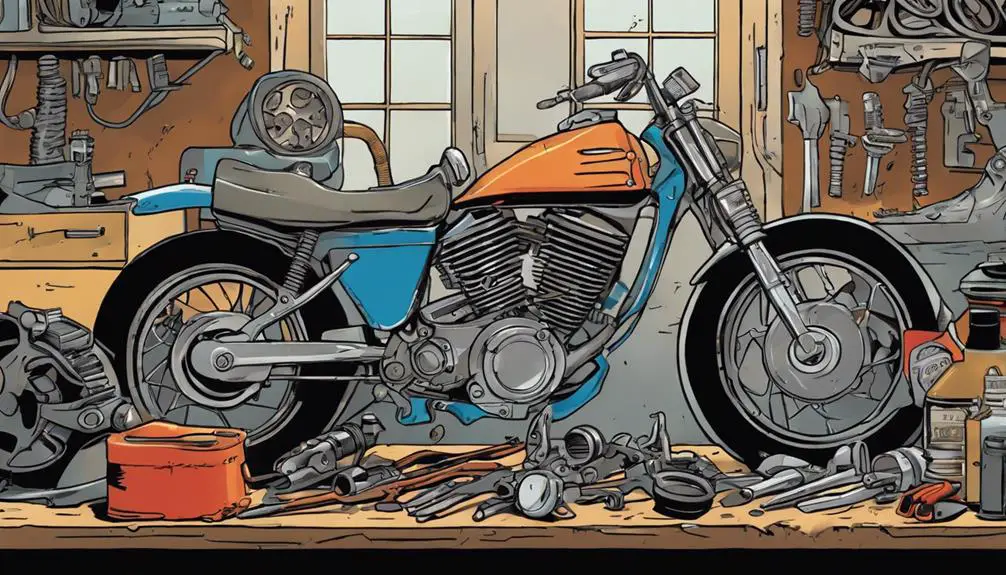Did you know that the reliability of your motorcycle can greatly impact its resale value? By understanding what affects these ratings over time, you can make informed decisions that enhance both performance and longevity. You might be surprised by how simple maintenance practices and awareness of common issues can transform your riding experience. To guarantee your bike remains dependable, consider a few essential tips that could keep it running smoothly for years to come. Let's explore how you can optimize your motorcycle's reliability ratings effectively.
Quick Takeaways
- Regular maintenance, including timely oil changes and inspections, is crucial for sustaining high reliability ratings over time.
- Pay attention to common issues reported by other riders to anticipate and address potential problems early.
- Invest in quality parts and accessories to enhance performance and longevity, minimizing the need for frequent repairs.
- Store your motorcycle properly and protect it from extreme weather to prevent environmental damage affecting reliability.
Understanding Reliability Ratings

When evaluating motorcycles, understanding reliability ratings helps you make informed decisions about your next ride. These ratings reflect how well a bike performs over time, offering insight into its durability and maintenance needs. You want a ride that won't leave you stranded on the open road, right?
Reliability ratings often come from user reviews, expert assessments, and manufacturer data. Pay attention to common issues reported by riders; they can reveal potential red flags. A high reliability rating means fewer repairs and more freedom to explore the world without worry.
It's essential to take into account how often a motorcycle requires maintenance. Some brands have a reputation for reliability, while others may demand more frequent care. Your ideal ride should empower you, not tie you down with constant upkeep.
Don't forget to research various models and their performance over time. Prioritize motorcycles with consistent reliability ratings, as they're more likely to provide you with the liberation you crave.
Historical Performance of Suzuki
Suzuki has built a strong reputation over the years for producing reliable motorcycles that consistently perform well in various riding conditions. When you look back at Suzuki's history, you'll find a brand that's dedicated to quality and innovation. From the classic models of the 70s to today's cutting-edge machines, Suzuki has delivered bikes that riders trust.
You'll notice that many Suzuki motorcycles offer impressive longevity, often requiring minimal maintenance. This reliability means you can focus on the freedom of the open road rather than worrying about mechanical failures. Riders appreciate the balance of performance and dependability, enabling you to explore diverse terrains without hesitation.
Moreover, Suzuki's commitment to improving their designs has led to numerous advancements in technology and efficiency. Their engineering prowess allows you to experience smooth rides, powerful engines, and excellent fuel economy, all while embracing the spirit of adventure.
In essence, Suzuki has consistently proven itself as a brand that champions reliability. By choosing a Suzuki motorcycle, you're not just getting a bike; you're investing in a legacy of performance that empowers your journey. Enjoy the ride and embrace the freedom that comes with Suzuki.
Common Issues Affecting Ratings

Motorcycle reliability ratings can be impacted by several common issues that riders often encounter. One major factor is maintenance neglect. If you skip regular oil changes or fail to check tire pressure, you're setting yourself up for breakdowns that can affect your bike's reliability score.
Another issue is electrical problems. Faulty wiring, corroded connectors, or aging batteries can lead to frustrating electrical failures. If your bike won't start when you're ready to hit the open road, it can ruin your adventure.
Mechanical failures, like transmission issues or brake malfunctions, can also drag down reliability ratings. When parts wear out and aren't replaced promptly, you compromise both safety and performance.
Lastly, environmental factors play a role. Riding in extreme weather or not properly storing your motorcycle can lead to corrosion and other damage.
Common Questions
How Do Changes in Manufacturing Affect Reliability Ratings?
Changes in manufacturing directly impact reliability ratings by altering the materials and processes used.
When manufacturers embrace innovative techniques or cut corners to save costs, you might see fluctuations in performance. If they prioritize quality control, reliability can soar.
Conversely, if they rush production or use inferior parts, you're likely to face more breakdowns.
Stay aware of these factors; they can profoundly affect your freedom on the road. Choose wisely!
Are Reliability Ratings Uniform Across Different Motorcycle Models?
Are reliability ratings uniform across different motorcycle models? Not really.
Each model's design, intended use, and build quality can lead to significant differences in reliability. You'll find that some bikes excel in durability, while others may face more frequent issues.
It's crucial to research specific models and read user reviews to understand what you're getting. Embracing this knowledge helps you make an informed choice, freeing you to enjoy the ride without unexpected breakdowns.
What Role Do Rider Habits Play in Motorcycle Reliability?
Your riding habits greatly impact your motorcycle's reliability. If you're consistent with maintenance, like oil changes and tire checks, you'll keep your bike in top shape.
Aggressive riding can wear out components faster, while gentle handling often extends their life.
You should also be mindful of how you store your bike. Proper care and smart riding choices can lead to a more dependable ride, allowing you to embrace the freedom of the open road.
How Often Are Reliability Ratings Updated or Revised?
You know how a trusty compass guides you through uncharted territory?
Reliability ratings for motorcycles aren't static; they're updated regularly, often annually or biannually, depending on the manufacturer.
Just like your riding experience evolves, these ratings reflect real-world data and rider feedback.
Staying informed lets you choose a bike that aligns with your adventurous spirit, ensuring that you're not just riding but thriving on the open road.
Embrace the freedom of knowledge!
Do Aftermarket Modifications Impact Reliability Ratings?
Aftermarket modifications can definitely impact reliability ratings.
When you customize your bike, you're altering its original design, which might lead to unforeseen issues.
While some mods enhance performance, others can strain components or create inconsistencies.
If you're chasing freedom on the open road, weigh the benefits against potential reliability concerns.
It's crucial to choose mods wisely to maintain your ride's dependability and guarantee your adventures are as smooth as possible.
Wrapping Up
As you take these steps to boost your motorcycle's reliability, ask yourself: what if a small oversight today leads to a major breakdown tomorrow?
By staying on top of maintenance, addressing common issues, and storing your ride properly, you're not just prolonging its life—you're ensuring every journey is worry-free.
So, are you ready to ride with confidence, knowing you've done everything to keep your motorcycle dependable?
The road ahead awaits, and it's calling your name.